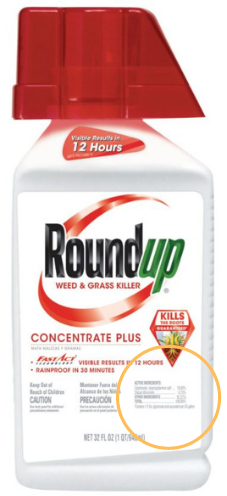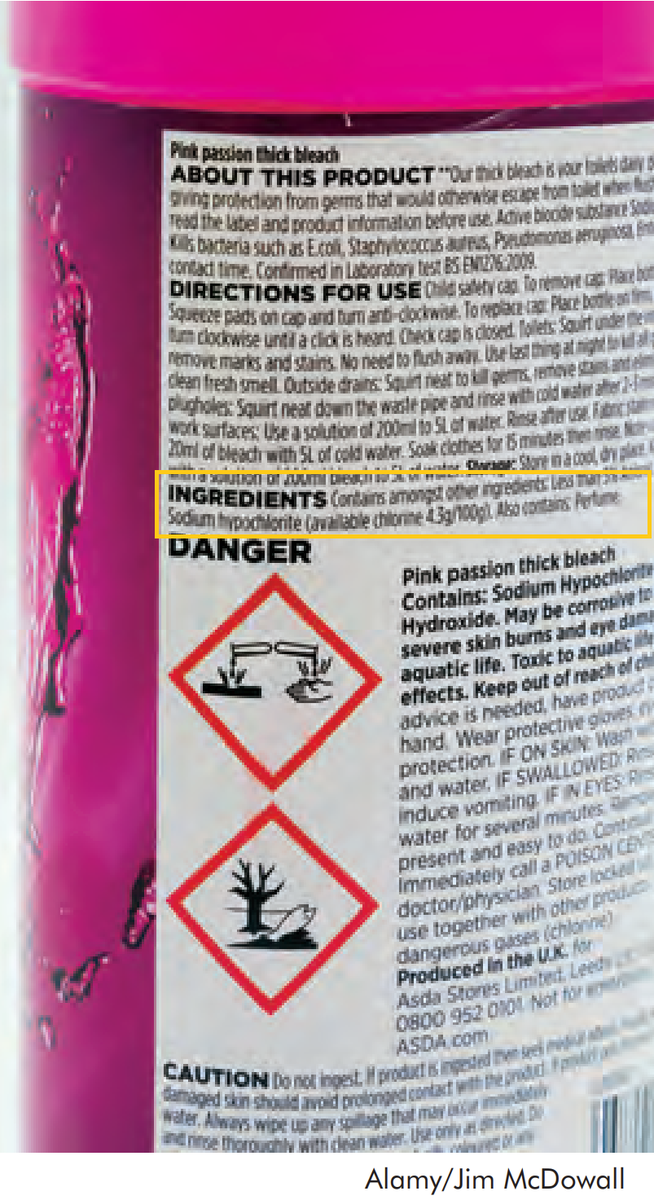Gateway on Pesticide Hazards and Safe Pest Management
How To Find Ingredients in Pesticide Products
Beyond Pesticides offers resources below to evaluate the health and ecological effects of specific chemical exposure from ACTIVE INGREDIENTS in pesticide products, as well as regulatory information and supporting scientific documents. Because various pesticide products can contain more than one active ingredient, it is important to READ the LABEL to determine chemical components.
With 192 different active ingredients and counting, it is essential to establish the connection between the use of these chemicals and their respective hazards.
View the step-by-step guide on how to search for the active ingredient(s) in pesticide products below:
- Go to U.S. EPA's Pesticide Product and Label System and enter the product name. The generic product name may vary.
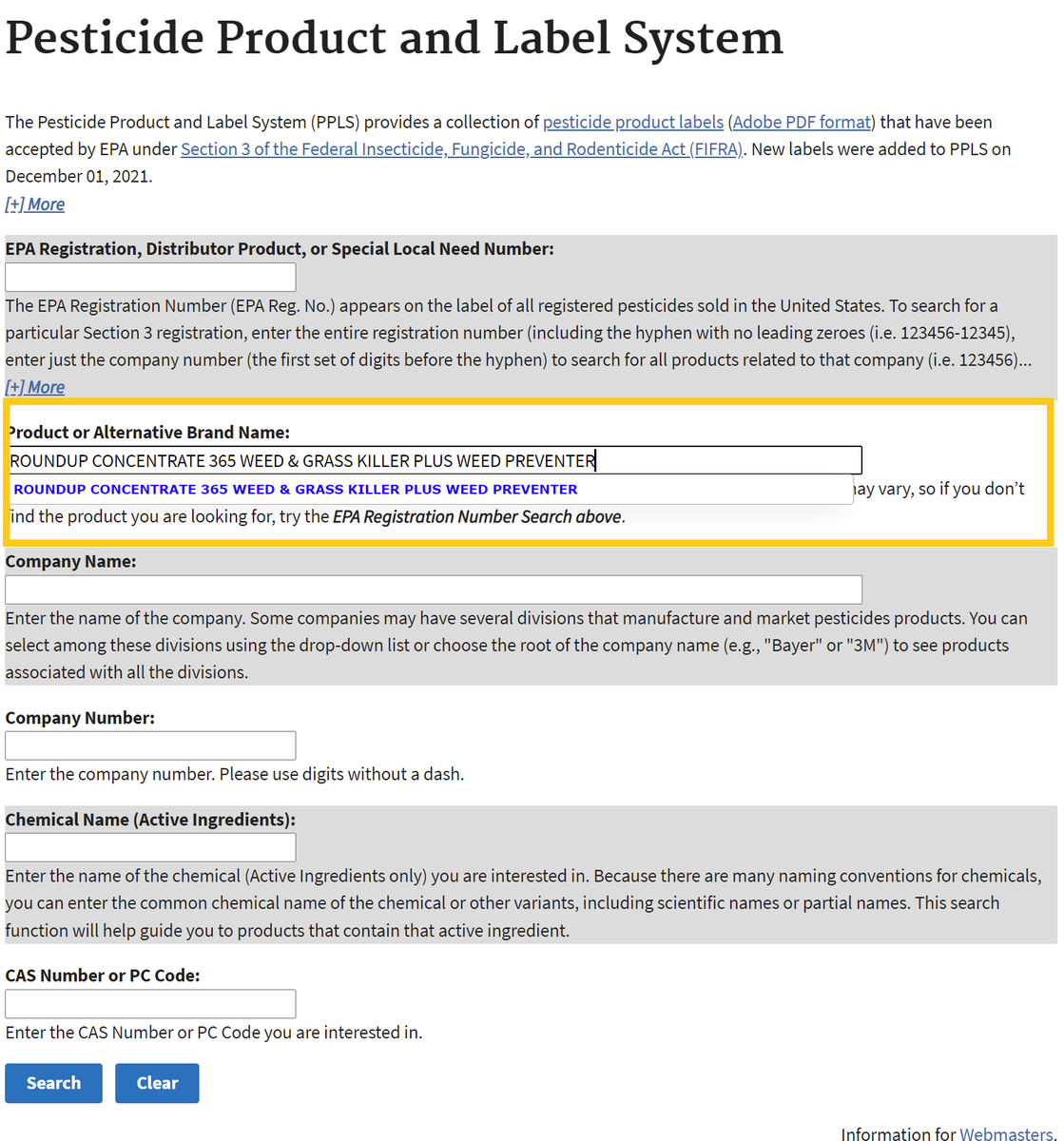
- After searching, click on the chemical ingredients tab or the link for the most recent label to find Active Ingredients.
Chemical List Label List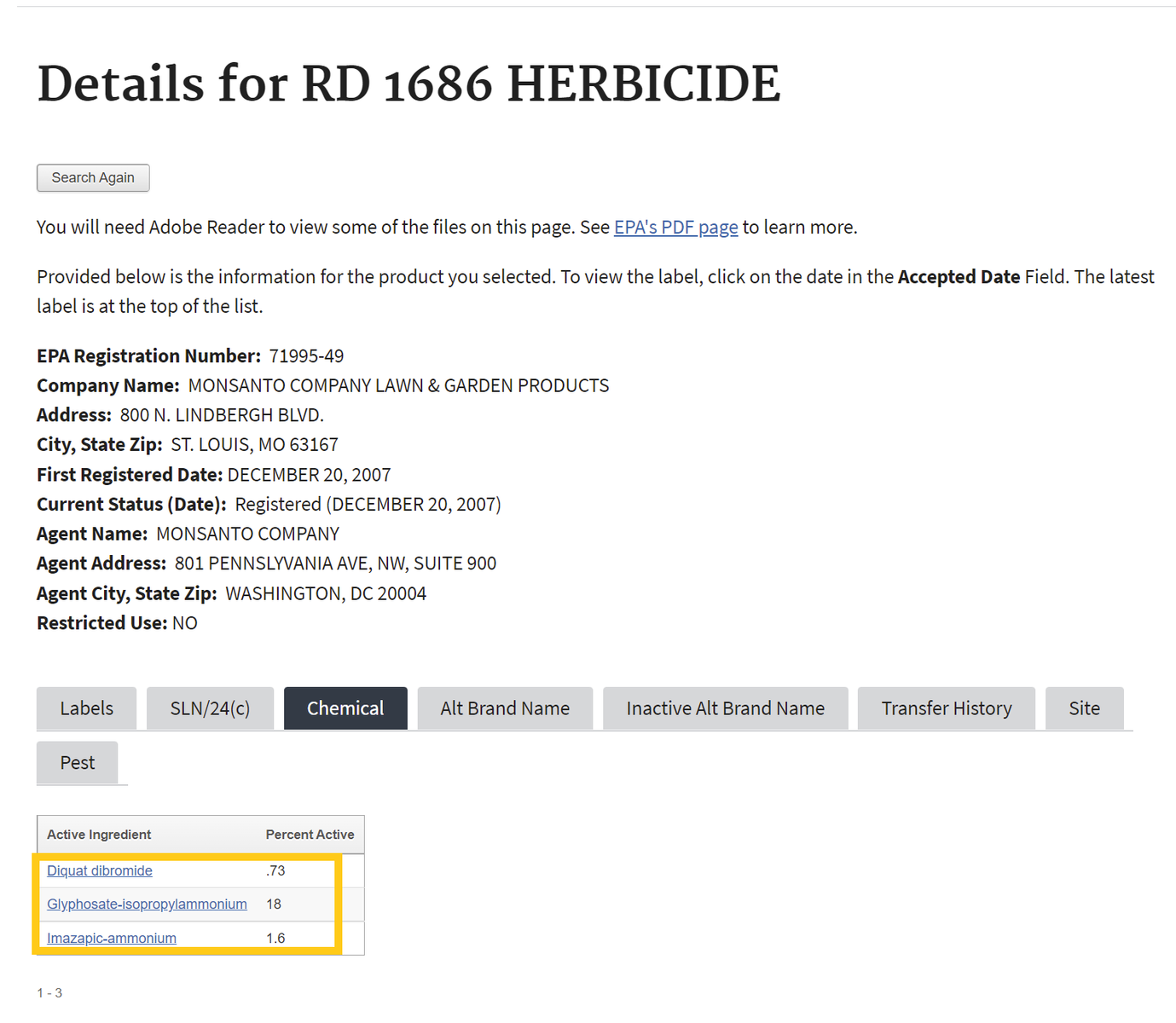
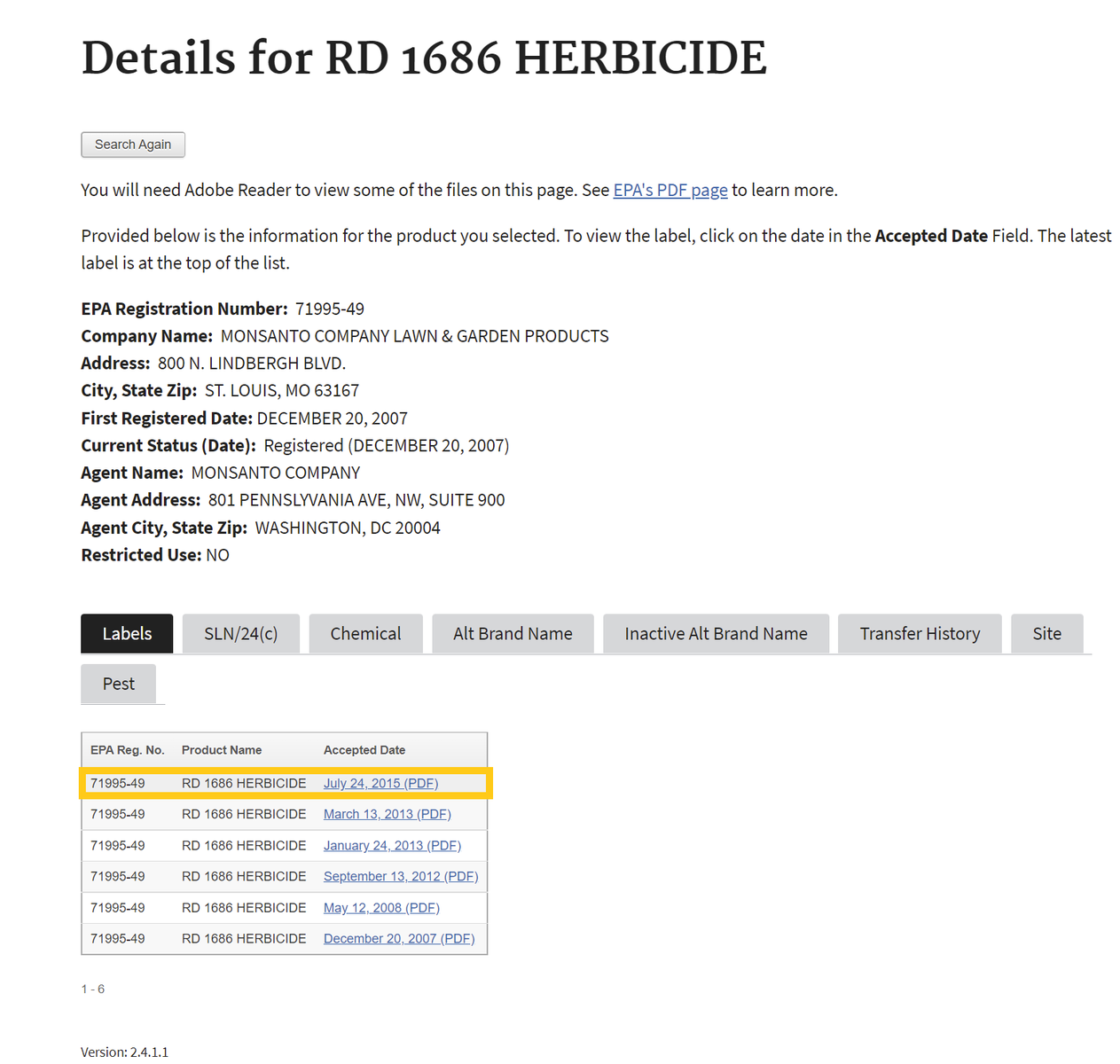
If one selects the chemical ingredients tab, skip to Step 4 . If not, proceed to step number 3 - To find the active ingredient(s) on the label, search for the page in the document containing the date of registration. Usually, the active ingredients section occurs within the first few pages of the label document.
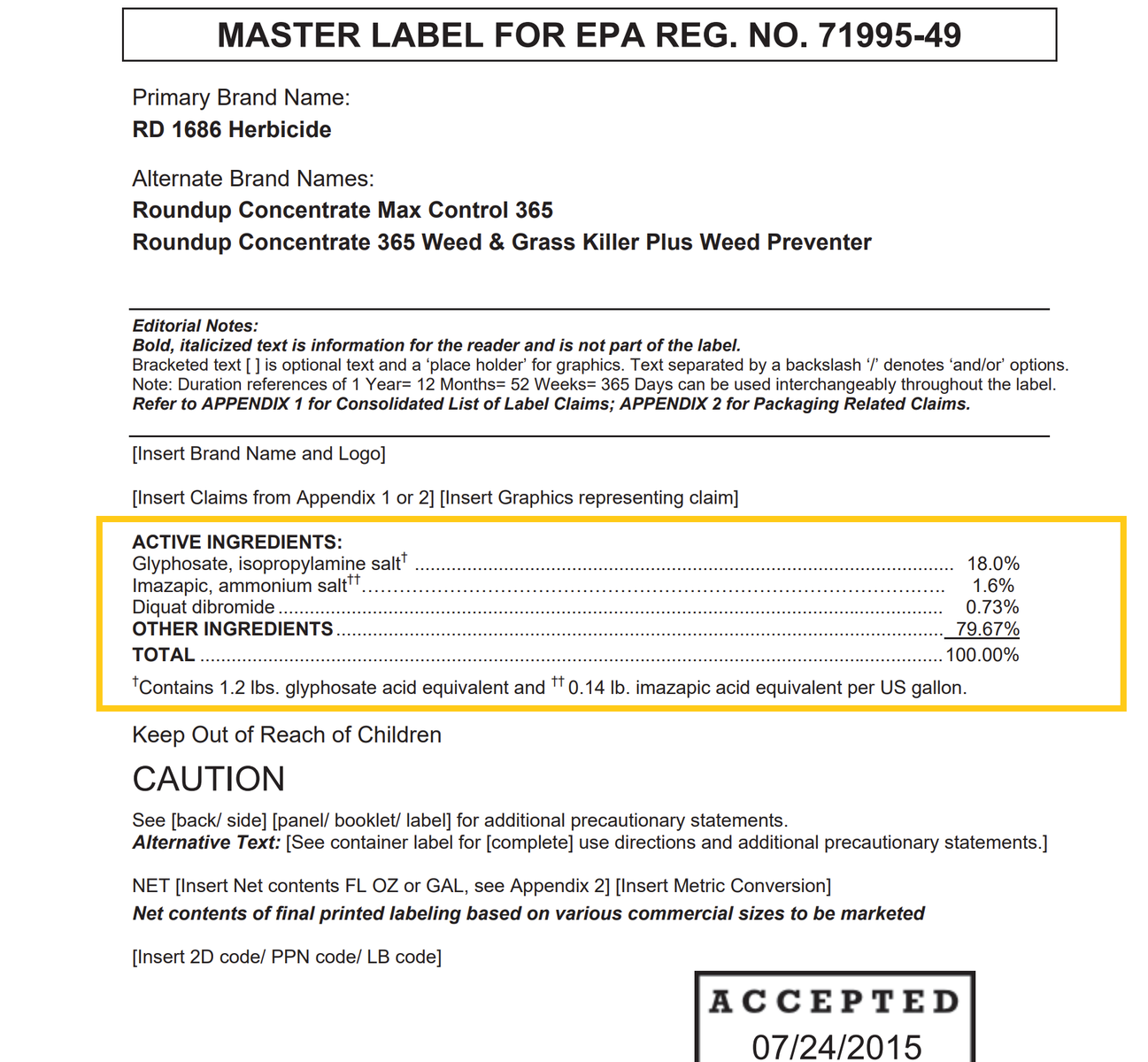
- Return to the Beyond Pesticides Gateway and search for the active ingredient name in the yellow box to the right or from the list below.
Deltamethrin
General Information
- Fact Sheet: Synthetic Pyrethroids.pdf
- Product Names:
- Chemical Class: Pyrethroid insecticide
- Uses: Agriculture, Christmas trees, Ornamentals
- Alternatives: Organic Agriculture, Organic christmas trees
- Beyond Pesticides rating: Toxic
Health and Environmental Effects
- Cancer: Not documented
- Endocrine Disruption: Yes (36)
- Reproductive Effects: Not documented
- Neurotoxicity: Yes (7)
- Kidney/Liver Damage: Not documented
- Sensitizer/ Irritant: Yes (4)
- Birth/Developmental: Not documented
- Detected in Groundwater: Not documented
- Potential Leacher: Not documented
- Toxic to Birds: Not documented
- Toxic to Fish/Aquatic Organisms: Yes (4)
- Toxic to Bees: Yes (4)
Residential Uses as Found in the ManageSafe™ Database
- Bed Bugs
- Carpenter Ants
- Carpenter Bees
- Cockroaches
- Spiders
- Ants
- Chiggers
- Chinch Bugs
- Fleas
- Gypsy Moths
- Hemlock Woolly Adelgid
- Pantry Moths
- Carpet Beetle
- Centipedes
- Grubs
- Ticks
- Wasps and Yellowjackets
Additional Information
- Regulatory Status:
- EPA Final Registration Review expected 2016
- Supporting information:
- Asthma, Children and Pesticides (Beyond Pesticides)
- Daily News Blog entries (Beyond Pesticides)
- Extoxnet Deltamethrin Factsheet (Extension Toxicology Network)
- PAN Pesticides Database: Deltamethrin (Pesticide Action Network)
- Scorecard Deltamethrin Factsheet (The Pollution Information Site)
- Studies:
- Ca²⁺ Movement Induced by Deltamethrin in PC3 Human Prostate Cancer Cells.. Lee HH, Chou CT, Liang WZ, Chen WC, et al. 2016. Chin J Physiol. 59(3):148-55.
- Developmental pesticide exposure reproduces features of attention deficit hyperactivity disorder.. Richardson JR, Taylor MM, Shalat SL, Guillot TS, et al. 2015. FASEB J. 29(5):1960-72
- ASSESSMENT OF POTENTIAL RISK TO HUMAN HEALTH FOLLOWING USE OF AZAMETHIPHOS, DELTAMETHRIN AND HYDROGEN PEROXIDE IN FISH FARMS. WCA Environment Ltd.
- Developmental pyrethroid exposure causes a neurodevelopmental disorder phenotype in mice. . Curtis, M.A., Dhamsania, R.K., Branco, R.C., Guo, J.D., Creeden, J., Neifer, K.L., Black, C.A., Winokur, E.J., Andari, E., Dias, B.G. and Liu, R.C., 2023.PNAS nexus, 2(4), p.pgad085.
- Exposure to pesticides and risk of Hodgkin lymphoma in an international consortium of agricultural cohorts (AGRICOH). Kim, J., Leon, M.E., Schinasi, L.H., Baldi, I., Lebailly, P., Freeman, L.E.B., Nordby, K.C., Ferro, G., Monnereau, A., Brouwer, M. and Kjaerheim, K., 2023. Cancer Causes & Control, pp.1-9.
- A Comprehensive Review on Pesticide Residues in Human Urine. Hakme, E., Poulsen, M. and Lassen, A. (2024) A Comprehensive Review on Pesticide Residues in Human Urine, Journal of Agricultural and Food Chemistry. Available at: https://pubs.acs.org/doi/abs/10.1021/acs.jafc.4c02705.
- Advances and future prospects of pyrethroids: Toxicity and microbial degradation. Singh, S. et al. (2022) Advances and future prospects of pyrethroids: Toxicity and microbial degradation, Science of The Total Environment. Available at: https://www.sciencedirect.com/science/article/abs/pii/S0048969722016540.
- A Review on Non-target Toxicity of Deltamethrin and Piperonyl Butoxide: Synergist. Basak, Mrinmoy and Choudhury, Rejwan Ahmed and Goswami, Priyanka and Dey, Biplab Kumar and Laskar, Moksood Ahmed (2021) A Review on Non-target Toxicity of Deltamethrin and Piperonyl Butoxide: Synergist. Journal of Pharmaceutical Research International, http://scholar.researcherseuropeans.com/id/eprint/323/
- Subacute oral toxicity of combinations of selected synthetic pyrethroids, piperonyl butoxide, and tetramethrin in rats. Yavuz O, Aksoy A, Das YK, et al. (2013). Subacute oral toxicity of combinations of selected synthetic pyrethroids, piperonyl butoxide, and tetramethrin in rats. Toxicology and Industrial Health. https://journals.sagepub.com/doi/abs/10.1177/0748233712469651
- Insecticide Resistance and Its Intensity in Populations of Malaria Vectors in Colombia. Orjuela, L. et al. (2018) Insecticide Resistance and Its Intensity in Populations of Malaria Vectors in Colombia, BioMed Research International. Available at: https://onlinelibrary.wiley.com/doi/10.1155/2018/9163543.
- Honey Bee (Apis mellifera) Exposure to Pesticide Residues in Nectar and Pollen in Urban and Suburban Environments from Four Regions of the United States. Démares, F.J. et al. (2022) Honey Bee (Apis mellifera) Exposure to Pesticide Residues in Nectar and Pollen in Urban and Suburban Environments from Four Regions of the United States, Environmental Toxicology and Chemistry. Available at: https://setac.onlinelibrary.wiley.com/doi/10.1002/etc.5298.
- Olfactory Learning Behavior and Mortality of the Honey Bee Apis mellifera jemenitica in Response to Pyrethroid Insecticide (Deltamethrin). Abuagla, M. I. B., Iqbal, J., Raweh, H. S. A., & Alqarni, A. S. (2024). Olfactory Learning Behavior and Mortality of the Honey Bee Apis mellifera jemenitica in Response to Pyrethroid Insecticide (Deltamethrin). Toxics, 12(1), 25. https://doi.org/10.3390/toxics12010025
- Subacute poisoning of mice with deltamethrin produces memory impairment, reduced locomotor activity, liver damage and changes in blood morphology in the mechanism of oxidative stress. Barbara Nieradko-Iwanicka, Andrzej Borzęcki, Subacute poisoning of mice with deltamethrin produces memory impairment, reduced locomotor activity, liver damage and changes in blood morphology in the mechanism of oxidative stress, Pharmacological Reports, Volume 67, Issue 3, 2015, Pages 535-541, ISSN 1734-1140, https://doi.org/10.1016/j.pharep.2014.12.012.
- Hippocampal ER Stress and Learning Deficits Following Repeated Pyrethroid Exposure. Muhammad M. Hossain, Emanuel DiCicco-Bloom, Jason R. Richardson, Hippocampal ER Stress and Learning Deficits Following Repeated Pyrethroid Exposure, Toxicological Sciences, Volume 143, Issue 1, January 2015, Pages 220–228, https://doi.org/10.1093/toxsci/kfu226
- Effects of Deltamethrin on striatum and hippocampus mitochondrial integrity and the protective role of Quercetin in rats. Gasmi, S., Rouabhi, R., Kebieche, M. et al. Effects of Deltamethrin on striatum and hippocampus mitochondrial integrity and the protective role of Quercetin in rats. Environ Sci Pollut Res 24, 16440–16457 (2017). https://doi.org/10.1007/s11356-017-9218-8
- Protective effects of syringic acid on neurobehavioral deficits and hippocampal tissue damages induced by sub-chronic deltamethrin exposure. Eren Ogut, Rahime Sekerci, Guven Akcay, Fatos Belgin Yildirim, Narin Derin, Mutay Aslan, Leyla Sati, Protective effects of syringic acid on neurobehavioral deficits and hippocampal tissue damages induced by sub-chronic deltamethrin exposure, Neurotoxicology and Teratology, Volume 76, 2019, 106839, ISSN 0892-0362, https://doi.org/10.1016/j.ntt.2019.106839.
- Deltamethrin Intranasal administration induces memory, emotional and tyrosine hydroxylase immunoreactivity alterations in rats. Marina F. Souza, Marco A.M. Freire, Katty A.A.L. Medeiros, Lívia C.R.F. Lins, José M.M. Bispo, Auderlan M. Gois, Pollyana C. Leal, Rovena C.G.J. Engelberth, Alessandra M. Ribeiro, Regina H. Silva, Murilo Marchioro, José R. Santos, Deltamethrin Intranasal administration induces memory, emotional and tyrosine hydroxylase immunoreactivity alterations in rats, Brain Research Bulletin, Volume 142, 2018, Pages 297-303, ISSN 0361-9230, https://doi.org/10.1016/j.brainresbull.2018.08.007.
- Intracerebroventricular injection of deltamethrin increases locomotion activity and causes spatial working memory and dopaminergic pathway impairment in rats. Marina F. Souza, Katty Anne A.L. Medeiros, Lívia C.R.F. Lins, José M.M. Bispo, Auderlan M. Gois, Marco Aurelio M. Freire, Murilo Marchioro, José R. Santos, Intracerebroventricular injection of deltamethrin increases locomotion activity and causes spatial working memory and dopaminergic pathway impairment in rats, Brain Research Bulletin, Volume 154, 2020, Pages 1-8, ISSN 0361-9230, https://doi.org/10.1016/j.brainresbull.2019.10.002.
- Motor, memory, and anxiety-like behavioral impairments associated with brain-derived neurotrophic factor and dopaminergic imbalance after inhalational exposure to deltamethrin. Marina F. Souza, Katty A.A.L. Medeiros, Lívia C.R.F. Lins, José M.M. Bispo, Auderlan M. Gois, Edson R. Santos, Thiago H. Almeida-Souza, João E.C. Melo, Heitor S. Franco, Rodolfo S. Silva, Eduardo A. Pereira-Filho, Marco Aurelio M. Freire, José R. Santos, Motor, memory, and anxiety-like behavioral impairments associated with brain-derived neurotrophic factor and dopaminergic imbalance after inhalational exposure to deltamethrin, Brain Research Bulletin, Volume 181, 2022, Pages 55-64, ISSN 0361-9230, https://doi.org/10.1016/j.brainresbull.2022.01.004.
- A Th2-type immune response and low-grade systemic inflammatory reaction as potential immunotoxic effects in intensive agriculture farmers exposed to pesticides . Lozano-Paniagua, D. et al. (2024) ‘A th2-type immune response and low-grade systemic inflammatory reaction as potential immunotoxic effects in intensive agriculture farmers exposed to pesticides’, Science of The Total Environment, 938, p. 173545. doi:10.1016/j.scitotenv.2024.173545.
- Toxicity of pesticides toward human immune cells U-937 and HL-60. Barbasz, A. et al. (2020) ‘Toxicity of pesticides toward human immune cells U-937 and HL-60’, Journal of Environmental Science and Health, Part B, 55(8), pp. 719–725. doi:10.1080/03601234.2020.1777059.
- Pesticide-Induced Inflammation at a Glance. Lopes-Ferreira, M. et al. (2023) ‘Pesticide-induced inflammation at a glance’, Toxics, 11(11), p. 896. doi:10.3390/toxics11110896.
- Lethal and sublethal effects of seven insecticides on three beneficial insects in laboratory assays and field trials. Fernandes, M. et al. (2016) Lethal and sublethal effects of seven insecticides on three beneficial insects in laboratory assays and field trials, Chemosphere. Available at: https://www.sciencedirect.com/science/article/abs/pii/S0045653516306051.
- Pesticide Residues on Three Cut Flower Species and Potential Exposure of Florists in Belgium. Toumi, K., Vleminckx, C., Van Loco, J., & Schiffers, B. (2016). Pesticide Residues on Three Cut Flower Species and Potential Exposure of Florists in Belgium. International Journal of Environmental Research and Public Health, 13(10), 943. https://doi.org/10.3390/ijerph13100943
- Fate of pesticide residues in beer and its by-products. Hakme, E., Kallehauge Nielsen, I., Fermina Madsen, J., Storkehave, L. M., Skjold Elmelund Pedersen, M., Schulz, B. L., … Duedahl-Olesen, L. (2023). Fate of pesticide residues in beer and its by-products. Food Additives & Contaminants: Part A, 41(1), 45–59. https://doi.org/10.1080/19440049.2023.2282557
- Adverse Effects of Pesticides on the Ovary: Evidence from Epidemiological and Toxicological Studies. Wang, L., Ma, X. and Liu, J. (2025) Adverse Effects of Pesticides on the Ovary: Evidence from Epidemiological and Toxicological Studies, Environment & Health. Available at: https://pubs.acs.org/doi/full/10.1021/envhealth.4c00243.
- Occurrence of pyrethroids in the atmosphere of urban areas of Southeastern Brazil: Inhalation exposure and health risk assessment. Guida, Y., Pozo, K., Carvalho, G. O., Capella, R., Targino, A. C., Torres, J. P. M., & Meire, R. O. (2021). Occurrence of pyrethroids in the atmosphere of urban areas of Southeastern Brazil: Inhalation exposure and health risk assessment. Environmental pollution (Barking, Essex : 1987), 290, 118020. https://doi.org/10.1016/j.envpol.2021.118020
- Deltamethrin exposure induces oxidative stress and affects meiotic maturation in mouse oocyte. Jia, Z. Z., Zhang, J. W., Zhou, D., Xu, D. Q., & Feng, X. Z. (2019). Deltamethrin exposure induces oxidative stress and affects meiotic maturation in mouse oocyte. Chemosphere, 223, 704–713. https://doi.org/10.1016/j.chemosphere.2019.02.092
- Pyrethroids cypermethrin, deltamethrin and fenvalerate have different effects on in vitro maturation of pig oocytes at different stages of growth. Petr, Jaroslav & Chmelíková, Eva & Žalmanová, Tereza & Tumova, Lenka & Kheilova, Katerina & Kučerová-Chrpová, V & Jílek, F. (2012). Pyrethroids cypermethrin, deltamethrin and fenvalerate have different effects on in vitro maturation of pig oocytes at different stages of growth. Animal : an international journal of animal bioscience. 7. 1-9. 10.1017/S1751731112001140.
- Pyrethroid exposure alters internal and cuticle surface bacterial communities in Anopheles albimanus. Nsa Dada, Juan C Lol, Ana Cristina Benedict, Francisco López, Mili Sheth, Nicole Dzuris, Norma Padilla, Audrey Lenhart, Pyrethroid exposure alters internal and cuticle surface bacterial communities in Anopheles albimanus, The ISME Journal, Volume 13, Issue 10, October 2019, Pages 2447–2464, https://doi.org/10.1038/s41396-019-0445-5
- Assessment of genetic damage levels in agricultural workers exposed to pesticides in Paraíba, Brazil. Carvalho-Gonçalves, L. et al. (2025) Assessment of genetic damage levels in agricultural workers exposed to pesticides in Paraíba, Brazil, Environmental Toxicology and Pharmacology. Available at: https://www.sciencedirect.com/science/article/abs/pii/S1382668925000900.
- Monitoring of Non-Maximum-Residue-Level Pesticides in Animal Feed: A Study from 2019 to 2023. Giugliano, R., Armenio, V., Savio, V., Vaccaro, E., Ciccotelli, V., & Vivaldi, B. (2024). Monitoring of Non-Maximum-Residue-Level Pesticides in Animal Feed: A Study from 2019 to 2023. Toxics, 12(9), 680. https://doi.org/10.3390/toxics12090680
- Quantifying Pesticide Exposure Risk for Monarch Caterpillars on Milkweeds Bordering Agricultural Land. Olaya-Arenas P and Kaplan I (2019) Quantifying Pesticide Exposure Risk for Monarch Caterpillars on Milkweeds Bordering Agricultural Land. Front. Ecol. Evol. 7:223. doi: 10.3389/fevo.2019.00223
- Urinary pesticide biomarkers from adolescence to young adulthood in an agricultural setting in Ecuador: Study of secondary exposure to pesticides among children, adolescents, and adults (ESPINA) 2016 and 2022 examination data. Parajuli, R. et al. (2025) Urinary pesticide biomarkers from adolescence to young adulthood in an agricultural setting in Ecuador: Study of secondary exposure to pesticides among children, adolescents, and adults (ESPINA) 2016 and 2022 examination data, Data in Brief. Available at: https://www.sciencedirect.com/science/article/pii/S2352340925006067.
- Poisoning due to Pyrethroids. Bradberry, S.M., Cage, S.A., Proudfoot, A.T. et al. Poisoning due to Pyrethroids. Toxicol Rev 24, 93–106 (2005). https://doi.org/10.2165/00139709-200524020-00003
- Transcriptome analysis provides insight into deltamethrin-induced fat accumulation in 3T3-L1 adipocytes. Qi, Zexiu et al. “Transcriptome analysis provides insight into deltamethrin-induced fat accumulation in 3T3-L1 adipocytes.” Pesticide biochemistry and physiology vol. 184 (2022): 105114. doi:10.1016/j.pestbp.2022.105114
- Deltamethrin promotes adipogenesis via AMPKα and ER stress-mediated pathway in 3T3- L1 adipocytes and Caenorhabditis elegans. Yuan, Li et al. “Deltamethrin promotes adipogenesis via AMPKα and ER stress-mediated pathway in 3T3- L1 adipocytes and Caenorhabditis elegans.” Food and chemical toxicology : an international journal published for the British Industrial Biological Research Association vol. 134 (2019): 110791. doi:10.1016/j.fct.2019.110791
- Invertebrate community structure predicts natural pest control resilience to insecticide exposure. Greenop, Arran & Cook, Samantha & Wilby, Andrew & Pywell, Richard & Woodcock, Ben. (2020). Invertebrate community structure predicts natural pest control resilience to insecticide exposure. Journal of Applied Ecology. 57. 10.1111/1365-2664.13752.
- Effect of deltamethrin on weight and activities of cellulose and acetylcholinesterase of earthworm. Shi Yajing, Yan Shifa, Shi Yajuan, Lu Jing. Effect of deltamethrin on weight and activities of cellulose and acetylcholinesterase of earthworm Journal of Northeast Normal University (Natural Sciences Edition). 2004 ;36(3):91-94.








.png)
